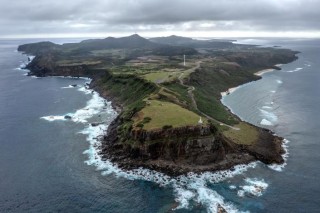Loading
Search
▼ Japan Warns Of ‘Aggressor Nation’ Russia, Threats To Taiwan In New Whitepaper
- Category:Other
The Russian invasion of Ukraine has taken a prominent position in Japan’s latest defense whitepaper, with the government warning the conflict represents “a new period of crisis” in this century.
The document, released last week in Japanese with an accompanying English-language digest, emphasized Russia’s defiance of international order is not just a European problem, and that the “international community is currently facing its greatest trial since [World War II].”
It added that the existing international order is exposed to serious challenges, especially in the Indo-Pacific region as strategic competition among nations becomes more apparent against the backdrop of changes to the balance of power.
The whitepaper also highlighted China’s ties with “aggressor nation” Russia, noting a trend of countries’ military aircraft conducting joint overflights in the airspace and ships patrolling waters near Japan.
It again highlighted China’s efforts to “unilaterally change or attempt to change the status quo by coercion in the East China Sea and South China Sea.”
It also noted China has made clear it will not hesitate to unify the self-ruling island of Taiwan, by force if necessary. Beijing considers Taiwan a rogue province. Japan noted that this rhetoric further increases tension in the region.
Japan described Taiwan in the whitepaper as “an extremely important partner for Japan, sharing the same fundamental values such as freedom and democracy.” The island’s stability was called “critical for Japan’s security and must be closely monitored with a sense of urgency.”
The document also encouraged the international community to recognize that changes to the status quo by coercion are globally shared challenges.
Japan is drawing up a new national security strategy to “preemptively deter changes to the status quo by force and to also be fully prepared for modern warfare, including information warfare and cyber warfare, both seen during Russia’s aggression against Ukraine,” the whitepaper read.
It is also continuing to establish its self-defense forces as an integrated, multidomain force that will integrate its capabilities in additional domains such as space, cyberspace and the electromagnetic spectrum. This move is perhaps most obvious in southern Japan as well as the islands between Okinawa and Taiwan.
Those areas have seen the establishment of several intelligence, surveillance and reconnaissance units, as well as groups dedicated to electronic warfare and anti-access missions.
The trend is set to continue in 2022, with the whitepaper noting that new electronic warfare units will be established this year in Ainoura, Sendai, Naha, Chinen, and Amami Oshima, while a new land-based, anti-ship missile unit will be set up in Kengun.
Japan is also continuing defense research and development efforts, with the country’s Acquisition, Technology and Logistics Agency working to make electromagnet rail guns, high-powered microwave energy systems to counter drone swarms, a loyal wingman drone and scramjet engine technology.
The document, released last week in Japanese with an accompanying English-language digest, emphasized Russia’s defiance of international order is not just a European problem, and that the “international community is currently facing its greatest trial since [World War II].”
It added that the existing international order is exposed to serious challenges, especially in the Indo-Pacific region as strategic competition among nations becomes more apparent against the backdrop of changes to the balance of power.
The whitepaper also highlighted China’s ties with “aggressor nation” Russia, noting a trend of countries’ military aircraft conducting joint overflights in the airspace and ships patrolling waters near Japan.
It again highlighted China’s efforts to “unilaterally change or attempt to change the status quo by coercion in the East China Sea and South China Sea.”
It also noted China has made clear it will not hesitate to unify the self-ruling island of Taiwan, by force if necessary. Beijing considers Taiwan a rogue province. Japan noted that this rhetoric further increases tension in the region.
Japan described Taiwan in the whitepaper as “an extremely important partner for Japan, sharing the same fundamental values such as freedom and democracy.” The island’s stability was called “critical for Japan’s security and must be closely monitored with a sense of urgency.”
The document also encouraged the international community to recognize that changes to the status quo by coercion are globally shared challenges.
Japan is drawing up a new national security strategy to “preemptively deter changes to the status quo by force and to also be fully prepared for modern warfare, including information warfare and cyber warfare, both seen during Russia’s aggression against Ukraine,” the whitepaper read.
It is also continuing to establish its self-defense forces as an integrated, multidomain force that will integrate its capabilities in additional domains such as space, cyberspace and the electromagnetic spectrum. This move is perhaps most obvious in southern Japan as well as the islands between Okinawa and Taiwan.
Those areas have seen the establishment of several intelligence, surveillance and reconnaissance units, as well as groups dedicated to electronic warfare and anti-access missions.
The trend is set to continue in 2022, with the whitepaper noting that new electronic warfare units will be established this year in Ainoura, Sendai, Naha, Chinen, and Amami Oshima, while a new land-based, anti-ship missile unit will be set up in Kengun.
Japan is also continuing defense research and development efforts, with the country’s Acquisition, Technology and Logistics Agency working to make electromagnet rail guns, high-powered microwave energy systems to counter drone swarms, a loyal wingman drone and scramjet engine technology.
- July 30, 2022
- Comment (0)
- Trackback(0)


